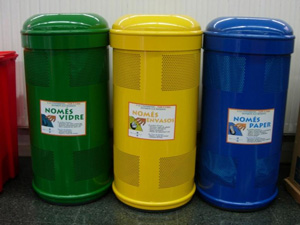Description
Throughout the day, we produce a large amount of waste that becomes a problem, both because of the lack of space available to store it and because of the economic and energy costs and the pollution associated with its subsequent treatment. For this reason, the first thing to achieve is to minimise the generation of waste, and then to sort the waste generated into selective collection bins.
Recycling allows us to convert materials that would become waste into a valuable product, as by re-processing the materials it contains we reduce the use of new natural resources. Furthermore, less energy is needed to produce products from recycled materials than if raw materials are used.
What can I do?
 Reduce your waste generation by buying products with little single-use packaging.
Reduce your waste generation by buying products with little single-use packaging.- Use reusable products. When you use single-use products you generate waste every time you use them, if they are reusable only once at the end of their useful life, which can be many years (for example, cups and mugs).
- It uses recycled products, where the consumption of energy and natural resources derived from their production has been lower. For example, producing recycled paper instead of virgin paper reduces water consumption by 85% and energy consumption by 65%.
- Recycle all the products that you can by placing them in the containers of
selective collection, or by taking them to green points or clean point.
Impact on the environment

*Image: Containers for selective waste collection at the Faculty of Pharmacy. OSSMA Image Bank (University of Barcelona)